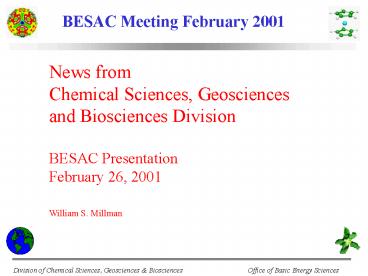BESAC Meeting February 2001 - PowerPoint PPT Presentation
1 / 12
Title:
BESAC Meeting February 2001
Description:
The U.S. position in catalysis research was recently evaluated by COSEPUP as ... Catalysis Futures Workshop. Understanding and Controlling Chemical Reactivity ... – PowerPoint PPT presentation
Number of Views:44
Avg rating:3.0/5.0
Title: BESAC Meeting February 2001
1
BESAC Meeting February 2001
News from Chemical Sciences, Geosciences and
Biosciences Division BESAC Presentation February
26, 2001 William S. Millman
2
BESAC Meeting February 2001
- Divisional Staffing
- New Activities in FY2001
- FY 2002 Budget
- Council Activities in FY2001
- Other Workshops in FY2001
3
Division Staffing Update
New Permanent Professional Staff Dr. Raul
Miranda - Catalysis Dr. Sharlene
Weatherwax - Biochemistry New Temporary
Professional Staff Dr. Julie dItri - Catalysis
(Pitt) Dr. Frank Tully (May) - Chem. Phys.
(SNL-CA) Continuing Temporary Professional
Staff Dr. Henry Shaw - Geochemistry (LLNL) Dr.
Roger Turpening - Geophysics (MTU) Departing
Temporary Professional Staff Dr. Dan Melamed
(April) - Catalysis (BNL) Dr. Richard Gordon
(May) - S A (Wash. St.) Dr. Norman Edelstein
(June) - HEC (LBNL)
4
Organization and Staffing
Chemical Sciences, Geosciences and Biosciences
Division
William Millman, Acting Director Karen Talamini,
Program Analyst Carolyn Dorsey, Secretary
Fundamental Interactions
Molecular Processes and Geosciences
Energy Biosciences
Paul Smith (Acting) Diane Matthews
Allan Laufer Sharon Bowser
Gregory Dilworth Patricia Snyder
Geochemistry and Geophysics
Atomic Molecular and Optical Physics
Plant and Microbial Biology
Nicholas Woodward lRoger Turpening, MTU uHenry
Shaw, LLNL (1/4 time)
Gregory Dilworth James Tavares
Eric Rohlfing
Catalysis and Chemical Transformations
Chemical Physics
Biochemistry Biophysics
William Kirchhoff u Frank Tully, SNL-CA
Raul Miranda (Catalysis) uDaniel Melamed,
BNL Julie dItri, Pitt
Sharlene Weatherwax Walter Stevens
Photochemical and Radiation Sciences
Separations and Analysis
Vacant (Separations) lDick Gordon, Wash. State
U. uNorman Edelstein, LBNL
Mary Gress Walter Stevens
Facilities Operations
Heavy Element Chemistry
William Millman William Kirchhoff Paul Smith
Paul Smith uNorman Edelstein, LBNL
l IPA u Detailee
Chemical Energy and Chemical Engineering
Paul Maupin
Office of Basic Energy Sciences
5
New Research Activities in FY 2001
Nanoscience
745 Preproposals for BES competing for up to
18M 432 Discouragement letters 313 Full
Applications Encouraged Due March 14
Approximately 1/3 CS, GS BS 46 Laboratory
FWPs - Under Review 4 Proposals from Each of 13
Labs Competing For Up To 18M 15 Nominally CS,
GS BS 31 Nominally MSE
Computational Chemistry (SciDac) 37
Preproposals received competing for 1.9M 21
Discouragement letters 16 Full Applications
Encouraged
Office of Basic Energy Sciences
6
Budget News for 2002
No News Yet
7
FY 2001Council Activities
Council for Chemical Sciences Emergent
Properties and Functions in Nanoscale Chemistry
1 Topic for workshop in FY2001 Charge Transfer
at the Nanoscale 5 Vacancies Filled
Council for Earth Sciences 1 Topic for Workshop
Proposed 1 Topical Contractors Meeting (Dec
7) 3 Vacancies to be Filled Next Meeting March
30
Council for Biosciences Tentative Date for First
Meeting - May
Office of Basic Energy Sciences
8
Catalysis Futures Workshop
Catalysis research in the U.S. The U.S. position
in catalysis research was recently evaluated by
COSEPUP as part of the study reported in
International Benchmarking of U.S. Materials
Science and Engineering Research.
- The U.S. is among the world leaders in catalysis
research - BUT
- There has been a decline of long-term research
in corporate laboratories -
AND - There has been no concomitant increase in the
effort in the - Universities nor Federal Laboratories as has
occurred in other countries.
9
Catalysis Futures Workshop
Understanding and Controlling Chemical Reactivity
- Enzymatic versus Traditional Catalysis
- New Ways to Approach Catalyst Synthesis
- and In-Situ Characterization
- Global Catalytic Processes
10
21st Century Chemistry Materials--Exploiting
Biologys 1st Billion Years
Biology gives us
moleculesDNA, proteins, carbohydrates
structuresmembranes, channels, fibers,
machines.
processesmolecular recognition, self-assembly,
pathways...
conceptscombinatorial chemistry, adaptation,
evolution
11
21st Century Chemistry Materials--Exploiting
Biologys 1st Billion Years
Designed templates for mineralization -protein
s -carbohydrates
Designed structures/scaffolds -e.g. for
nanostructures -DNA -RNA -proteins-gene-base
d or synthesizedin vitro/in vivo -carbohydrates
Motors, rotors, tractors, devices -tubulin
-kinesin -ATP synthase -sensors-reporters-imag
ers-detectors -enzyme catalysts
12
21st Century Chemistry Materials--Exploiting
Biologys 1st Billion Years
Pores/channels -selective transport
-separations -concentration
Interfaces -engineered cell/materials
surfaces for selective adhesion -designed
membrane-like surfaces for molecular
recognition -self-assembly--surfaces that
encode molecular recognition
gradients/tracks -adaptive surfaces--multi-poten
tial surfaces that respond to the molecular
environment































